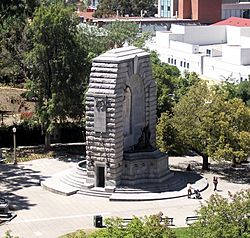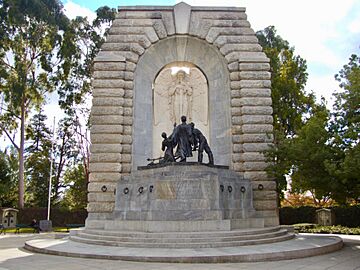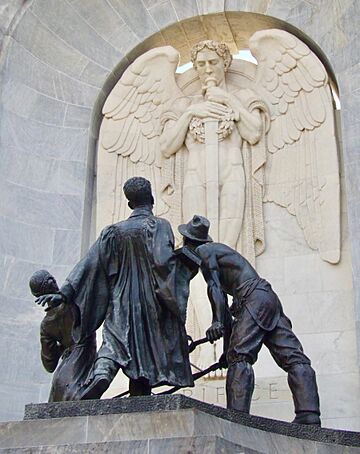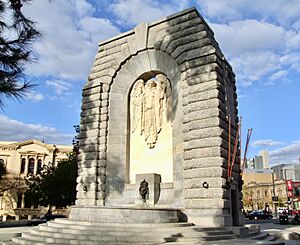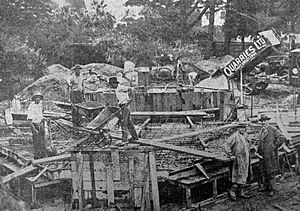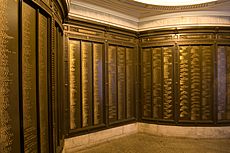National War Memorial (South Australia) facts for kids
The National War Memorial (South Australia) is a special monument in Adelaide, South Australia. It honors people from South Australia who fought in the First World War. It also remembers those who lost their lives in that war. The memorial was opened in 1931. You can find it on the corner of North Terrace and Kintore Avenue. It's right next to Government House. Important ceremonies are held here every year. These include Anzac Day on April 25 and Remembrance Day on November 11.
Contents
What the Memorial Means
This monument tells two stories. One side shows the start of war, and the other shows what happens after. They represent young people bravely answering the call to duty. They also show the great sacrifices they made. The memorial does not show actual fighting or soldiers.
The designers wanted to show a "spiritual victory." This means a willingness to serve and sacrifice. They said it shows:
- People giving up what they loved, even their lives.
- Men who joined, worked, fought, and died.
- Women who waited, worked, helped, and suffered.
History of the Memorial
The idea for this memorial came up in 1919. The government of South Australia paid for it. This made it the first Australian state war memorial planned after the war. The design was chosen through two art competitions.
First Design Competition (1924)
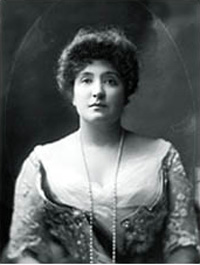
In 1924, a group called the National War Memorial Committee started a competition. They wanted to find a design for the new memorial. The goal was to remember the victory in the Great War (1914–1918). It also honored the sacrifices made and the national effort.
Only people from South Australia who were British subjects could enter. There was a small fee to join. The competition ended in September 1924. Three experts were chosen to judge the designs.
The committee had a budget of £25,000. They wanted the memorial to be at the entrance of Government House. This was at the corner of King William Street and North Terrace.
Many people had ideas for what the memorial should be.
- Famous singer Dame Nellie Melba suggested a carillon (a set of bells).
- Another idea was to make Anzac Highway a "Way of Honour" with triumphal arches.
- Someone else wanted a tall metal and marble monument on Mount Lofty.
Twenty-six designs were submitted. But on November 10, 1924, a fire destroyed the building where they were kept. All the designs were lost before judging was finished.
Second Design Competition (1926)
By 1926, not much progress had been made. There was a lot of talk about where the memorial should be built. Some politicians wanted to use the land of Government House. But legal problems stopped this plan. Instead, a part of the Government House grounds was set aside. This was at the corner of North Terrace and Kintore Avenue.
In 1926, a second competition was announced. The budget was still £25,000. Again, only South Australian British subjects could enter. This time, only one expert, John Smith Murdoch, judged the entries.
Eighteen designs were received. On January 15, 1927, the design by Louis Laybourne Smith was chosen as the winner. He was part of the architectural firm Woods, Bagot, Jory & Laybourne–Smith.
The winning design was praised by many. It used sculpture to tell the story of the memorial. The architects gave up most of their payment. They asked that the money (about £1000) be used to care for the monument instead.
Building the Memorial
Construction started in 1928. Marble blocks from Macclesfield and Angaston were used. Rayner Hoff, a sculptor from Sydney, created the designs for the statues. A South Australian company, A.W. Dobbie and Company, made the bronze castings.
There were delays during construction. Stonemasons went on strike, asking for better pay and shorter hours. The company building the memorial faced financial problems. The final cost of the memorial was about £30,000.
Opening Day
The National War Memorial in South Australia was the fourth state World War I memorial to open. It was unveiled on Anzac Day, April 25, 1931. This was the 16th anniversary of the Gallipoli landing. The Governor, Sir Alexander Hore-Ruthven, officially opened it.
Almost 75,000 people came to the opening. It was one of the biggest crowds the city had ever seen. Many thousands gathered at a different spot nearby to watch.
Remembering the Fallen
The first dawn service at the memorial was held on Anzac Day in 1935. About 200–300 people attended.
Restoring the Memorial
In 2001, the memorial was 70 years old. A three-month project was done to fix the bronze and stonework. They also made the foundations stronger. This work was finished just before Remembrance Day services. In 2002, the architects who did the restoration won an award for their work.
Design of the Memorial
The memorial stands over 14 meters (46 feet) tall. It is set back from North Terrace. This creates space for public gatherings and ceremonies.
The monument is like a frame for two main scenes. These scenes show the start and end of war. They are made of marble reliefs and bronze statues by Rayner Hoff. The two sides are called the reverse and the obverse, like the two sides of a coin.
The front side (obverse) faces North Terrace. It shows the Spirit of Duty appearing to young South Australians. These are a young woman, a student, and a farmer. They are leaving their tools behind. They are not yet soldiers and are looking towards the vision.
The back side (reverse) faces away from the road. It shows the Spirit of Compassion. This is a winged woman carrying a fallen young person. Below this figure is the Fountain of Compassion. The flowing water represents "constant memories." A lion's head, showing the British Commonwealth, is where the water comes from.
The designers said the memorial does not show a traditional "victory." Instead, it shows a spiritual victory. It represents a "willingness to serve and to sacrifice."
Inside the memorial is a special room called the Record Room. Here, the names of South Australians who died in the war are carved into bronze plaques. Other plaques list the names of all South Australians who served. Above the entrances, the names of major battle areas are written. These include Egypt, Gallipoli, Palestine, France, and Belgium.
The memorial is placed at a 45-degree angle to North Terrace. This allows the morning sun to shine on its front. It also lines up with other important landmarks nearby.
Other Memorials Nearby
The National War Memorial was first for the First World War. But now, other smaller memorials have been added around it.
- A memorial for the Battle of Lone Pine.
- The French Memorial, honoring South Australians who died in France in both World Wars. It was unveiled in 1993.
- An honor roll for those who died in World War II.
- The Australian Armed Forces Memorial. This includes conflicts like the Malayan Emergency (1948–1960), the Korean War, the Indonesia–Malaysia confrontation in Borneo, and the Vietnam War.
The wall around the memorial site has six "Crosses of Memory." These simple wooden crosses remember events like the siege of Tobruk (1941) and specific battalions from World War I. Along North Terrace, the Jubilee 150 Walkway honors those who received the Victoria Cross and George Cross.
-
Memorial to the 8th Division of the Second Australian Imperial Force
-
Battle of Lone Pine; the tree grew from a seedling related to the original Lone Pine
-
World War II VC & GC recipients:
Derrick, Gosse, Kibby, Matthews
See also
 In Spanish: Monumento conmemorativo nacional de la guerra (Australia del Sur) para niños
In Spanish: Monumento conmemorativo nacional de la guerra (Australia del Sur) para niños


